Occasional Ramsgate Writings Donald G Long | Click here to buy the book or veiw our other local books When I produced this book it occurred to me that the decedents of the people named in it might want a means of communicating with each other, if you click here you can leave comments for others to see, you don't have to join anything or fill in any forms, you can even comment anonymously should you wish to.
Occasional Ramsgate Writings Donald G Long | MOUNT ALBION HOUSE, RAMSGATE | ST PAUL'S CHURCH KING STREET, RAMSGATE | HERESON SCHOOL, RAMSGATE | HERESON AND HOLLICONDANE | CHATHAM HOUSE COLLEGE 1797-1917
HERESON SCHOOL, RAMSGATE
HERESON SCHOOL, RAMSGATE
1909-1959
The first fifty years of Hereson School are of special interest, made so by the times, with two world wars and changes brought about by various Education Acts.
The school was built as a result of the Education Act of 1902, when the Board of Education called upon the Education Committee of Ramsgate Borough Council to put into operation the building of a school. This had proved a difficult task, which had aroused sectarian views as well as opposition of local bodies and people in the selection of the site, so that it was five years before the foundation stone was laid on the Lillian Road site.
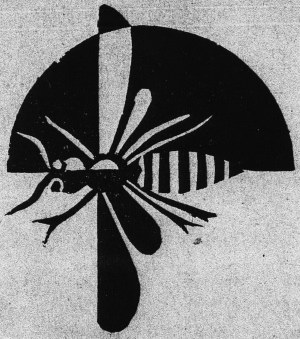 The Hornet
The Hornet The school was officially opened on 10th September 1909, and was called the Lillian Road Council School. It was the first elementary council school erected in . Ramsgate. Councillor William Coleman, the Chairman of the Ramsgate Borough Education Committee, ceremoniously unlocked one of the doors, the flag was hoisted and the band of the 16th Lancers played the National Anthem. The large gathering then moved to the hall where the assembly was first addressed by the Deputy Mayor of Ramsgate, Councillor Radcliffe, who said that the buildings might very properly be termed a Children's Palace, for he was sure they must exceed the wildest dreams that the children had ever conceived of what must be fairyland, and that the popularity of the schools was already acclaimed by the enormous rush of children to enter. The new Lillian Road schools were considered by some to be the latest development in
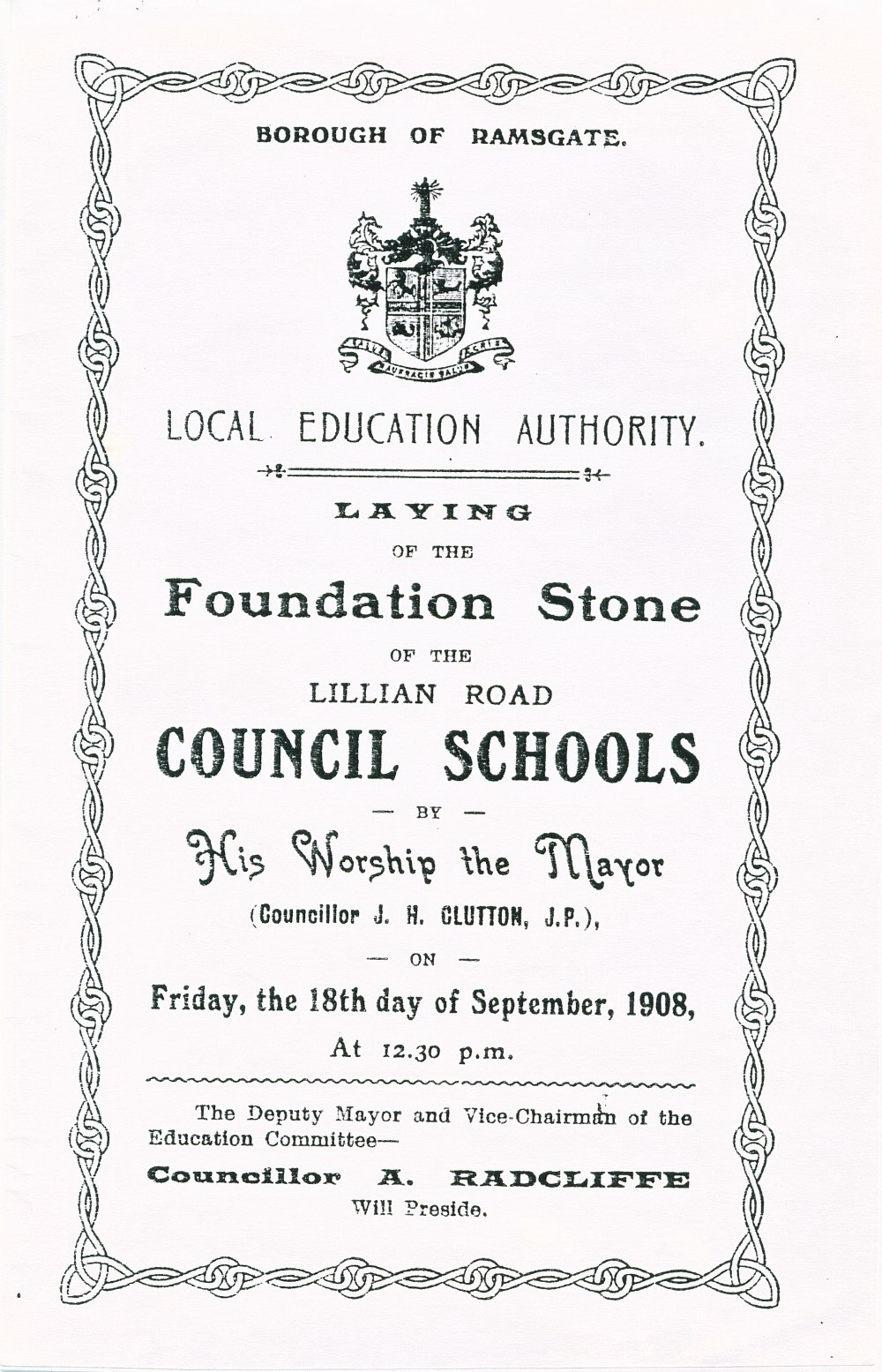
educational establishments, far in advance with regard to construction and equipment of schools built twenty or thirty years before.
The original plan had been to build a school for only 100 pupils. A piece of land on the opposite side of Lillian Road had also been acquired for the building of an Infants' School. The school was in fact designed to accommodate 760 pupils - 380 boys and 380 girls. The girls were to occupy the lower floor, entering by the two lower front entrances, which later were reserved for the staff, prefects and visitors, while the boys went upstairs, admitted by the entrance at the top of Lillian Road and then through the rear doors leading to the stairs. Each floor had eight classrooms: two for 60 pupils, two for 50 pupils and four for 40 pupils. The total cost of the building, which met the demands of the Board of Education of the day in every particular, was £10,800, and 'the furniture', according to Mr T.G. Taylor, the architect, was 'of the best description' and cost £475. The desks were of the dual type, made from Orham or Canadian elm, a wood which had proved itself most suitable for hard use, and were of excellent design, particularly with regard to freedom from danger to the children from trapped fingers, strength of construction and especially the upright position a child must take when using the desk. The Education Rate in Ramsgate was 8 ½ d in the £, and the loan of £800 raised to pay for the building site took some years to pay off!
The Headmaster, Mr Percy Solly, had first been a schoolboy and then a teacher at St George's School, while the Headmistress, Miss M. Butler, had been teaching at Ellington. Eight teachers in all were transferred from St George's and five from Ellington, so that there were seven teachers at the Boys' School (at an average salary of under £2 per week!) and eight at the Girls' School (average salary just over thirty shillings per week).
On opening there were 235 girls and 385 boys. These numbers steadily mounted during the following months until by 1910 there were 312 girls and 403 boys on roll. By 1914 the numbers had risen to 400 girls and 416 boys, exceeding the generous limits set originally by 56 pupils. All these children were of the ages seven to fourteen.
Some of the lessons studied then, in addition to the three Rs - Reading, wRiting and aRithmetic - were singing, recitation, drill and physical exercises, with drawing for the lower classes, 5 to 7, and brushwork for the upper classes, 11 to 14, while in the Girls' School French lessons were started in 1911, but these were discontinued two years later. It appears there was also an Evening Continuation School for pupils over 13V2.
Some items of interest include the breakdown of the school heating system, when temperatures in the classrooms were anything from 43°F down to 38°F.
On 9th May 1910 all the blinds in the school were drawn and the school was darkened and hushed for the funeral of King Edward VII. But of course on the Coronation of King George V in 1911 a half-holiday was granted.
On 2nd June 1911 many boys were absent doing their paper rounds when the 'paper' trains ran in late, and the log book of those days also records many occasions when the boys and girls were still in the hopfields at the commencement of the Autumn Term in September.
School visits to Ramsgate cinemas are also not as new as some might think. From the 1930s to the 1950s these were used for educational purposes. The first recorded at the school was on 30th September 1913, when a visit was paid to the Pavilion at Ramsgate Harbour to see moving pictures accompanying a talk on Nature's Zoo.
A fortnight later a collection of £2.10s was made in aid of the Cardiff Miners' disaster.
The First World War
The First World War started in August 1914 and the school was soon involved, for on the anniversary of Trafalgar Day, 21st October 1914, celebrations were held in the playground for which classes had to learn, practise and sing the Tsarist Russian, the French, the Belgian and the apanese National Anthems!
But the pupils also contributed far more practically, for they immediately started collecting money for a Wool Fund to enable the girls to knit socks, belts and helmets for the soldiers, and also arranged concerts to raise money. The girls must have worked very hard, for on 4th November 1914 they sent off 16 pairs of socks, 8 helmets and 6 belts, while a month later they despatched 105 knitted garments to a national newspaper organising such gifts. The next year they also made sandbags, of which 195 were sent up on 11th November 1915. In the first year three masters from the Boys' School went to serve in the Forces. There were several staff changes at this time, and a woman teacher was permanently transferred from the Girls' School to the Boys' School.
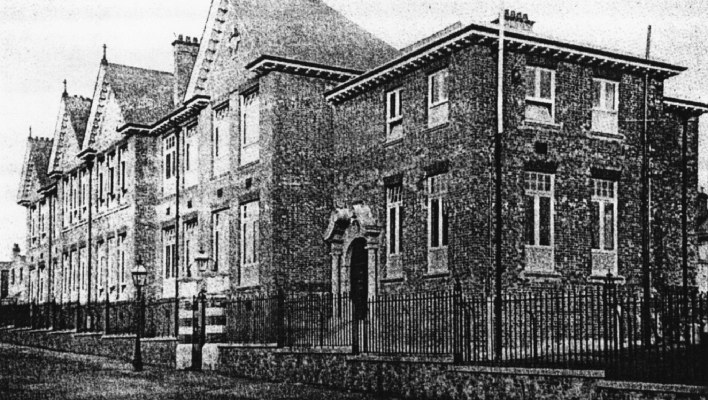 The School Buildings
The School Buildings It was not long before names of old boys of the school who had been killed in action came in, and the first twenty-four names were entered on the Roll of Honour board. What became of the board and the total number of old boys who died in the war is not known.
The children and teachers were brought into the front line with the onset of bombing raids in Ramsgate. The first Zeppelin (German airship) raid recorded was on 16th May 1915. The attendance at school was down as a result of this, and occurred after every raid. On 9th February 1916 bombs were dropped within 200 yards of the school just as the pupils were leaving to go home. Five weeks later, during a raid at night, two Lillian Road pupils were killed and four injured. Raids were also recorded in June 1916 and 1917, and then became so repeated in the summer of 1917 that the school was closed from 2nd August until 29th October. No sooner had the school started, then there was another raid on 31st October, and these continued at intervals until the end of the war. There was also a heavy German Naval bombardment of Ramsgate in April 1917.
The Air Raid drill for the pupils was to move the desks away from the windows and then sit under them with the blinds drawn. Towards the end of the war dugouts were built in the infants' playground for the girls, and in Honeysuckle Hill for the boys.
The signing of the Armistice was celebrated by a short gathering in the playground to the sound of ships' sirens and buzzers, followed by a holiday for the rest of the day.
Mr F.W. Brown, MCFA, who was a pupil at the school from its start until 1916, had a good memory, and here is the school song by Mr Solly (known by the boys as 'Pussa'). It runs as follows:
We're together now, we shall part someday,
Let us sing a song that will last for aye.
A song that we'll hum when far, far away,
At the sound of the Bell in the morning.
For the Bell means school, our Lillian Road School,
And the Bell means work for the sake of the School,
And the Bell means play, but don't play the fool,
As we'll answer its call in the morning.
Then we'll all play up and we'll play the game,
And do nothing to smirch our School's good name,
And in years to come we'll remember the name
At the sound of the Bell in the morning.
It was sung to the tune of 'D'ye Ken John Peel'.
The boys of Lillian Road School, with whom this chronicle is chiefly concerned, also had a nickname - one that was given to them at the opening of the school in 1909 - 'The Hornets'. The school colours were black and amber, and one could also imagine that over 400 boys in the upper half of the school would often have given the appearance of a swarm. This name in Ramsgate created a fine tradition in that it could frequently be heard on the sports fields of the area, and they say on the battlefields of the world during both world wars, the cry was 'Up the Hornets!', with a sting in their tail - quite a tradition.
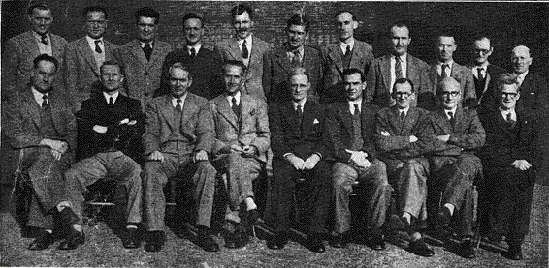 Staff photograph, 1950. Back row: T. Wilcox, L. Daisy, D. Perkins, P. Brett, S. Green, F. Wilkenning, N. Belt, J. Hollies, J. OIlis, C. Stroud, W. Robinson.
Staff photograph, 1950. Back row: T. Wilcox, L. Daisy, D. Perkins, P. Brett, S. Green, F. Wilkenning, N. Belt, J. Hollies, J. OIlis, C. Stroud, W. Robinson. Front row: G. Evans, A. Shepherd, V. Fox, W. Copping, W. Davies, T. Cobb, H. Young, T.J. Hynes, A. Robinson. (Photograph by Mr T. Wilcox)
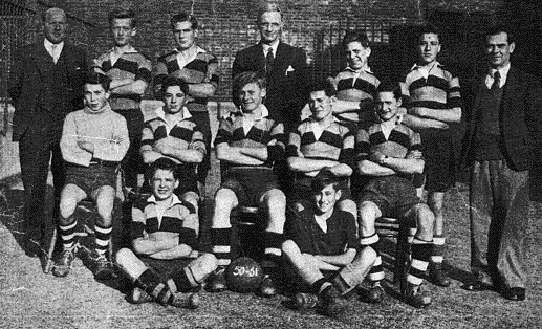 School Football Team, 1950. Back row: Mr W. Robinson, M. Riley, L. Revell, Mr W. Davies, A. Moys, D. Barden, Mr T. Cobb. Middle row: M. Taylor, A. Shadbolt, M. Evans, T. Pidduck, A. Rogers. Front row: R. Clarke, K. Evans.
School Football Team, 1950. Back row: Mr W. Robinson, M. Riley, L. Revell, Mr W. Davies, A. Moys, D. Barden, Mr T. Cobb. Middle row: M. Taylor, A. Shadbolt, M. Evans, T. Pidduck, A. Rogers. Front row: R. Clarke, K. Evans.(Photograph by Mr T. Wilcox)
With the First World War over the school began to return to normal. Members of staff came home from active service and the whole school looked forward to many years of peace.
In September 1921 a school playing field was established at West Dumpton with organised games for both boys and girls. During these years football had developed so much that G. Paramor, the school Captain of Football, was chosen to play in Paris - who for, however, is not recorded. Honours also came in other directions. The school had on its staff Mr Lohmann, a Kent County chess player, who soon built up a good chess tradition in the school. In March 1930 the school's chess team beat Chatham House Grammar School.
It was at this time that numbers on the roll increased and the classes were becoming very overcrowded. By November 1924 there were eight boys' classes, three of them having 59 boys and the lowest being 54 boys. Headmaster Mr Solly sadly recorded at the time that they were 'often overfull'. The position was much the same in the girls' school. Mr Solly retired on 31st October 1930 and was" replaced by Mr W.A. Davies.
The Education Act of 1902 was responsible for its founding. Mr Davies had taken over the responsibility of implementing the Hadow Report of 1926. This had advocated that all children over the age of eleven years should receive secondary education in the broadest sense of the word. The history of all such Acts, however, has been of very slow application, with often no progress at all. It therefore not surprising that it took until 1946 for the school to be divided into two departments -Juniors 7-11 and Seniors 11-14.
School excursions were made in these years with large party visits to Windsor Castle, Hampton Court, down the River Thames, Southampton Docks and the Science Museum, among other places. In addition, small party visits were made to places of educational interest in Ramsgate and the surrounding area.
In 1931, on the recommendation of the Headmaster, the old name of 'Lillian Road' was changed to 'Hereson', for it was felt that a district name was more appropriate than that of a road or street in which a school is situated.
Football came to prominence in 1937 when the school won the Winter Shield, the Larkin Cup, the Mockridge Cup, the Coleman Cup and, as was to be expected, won the League Championship as well.
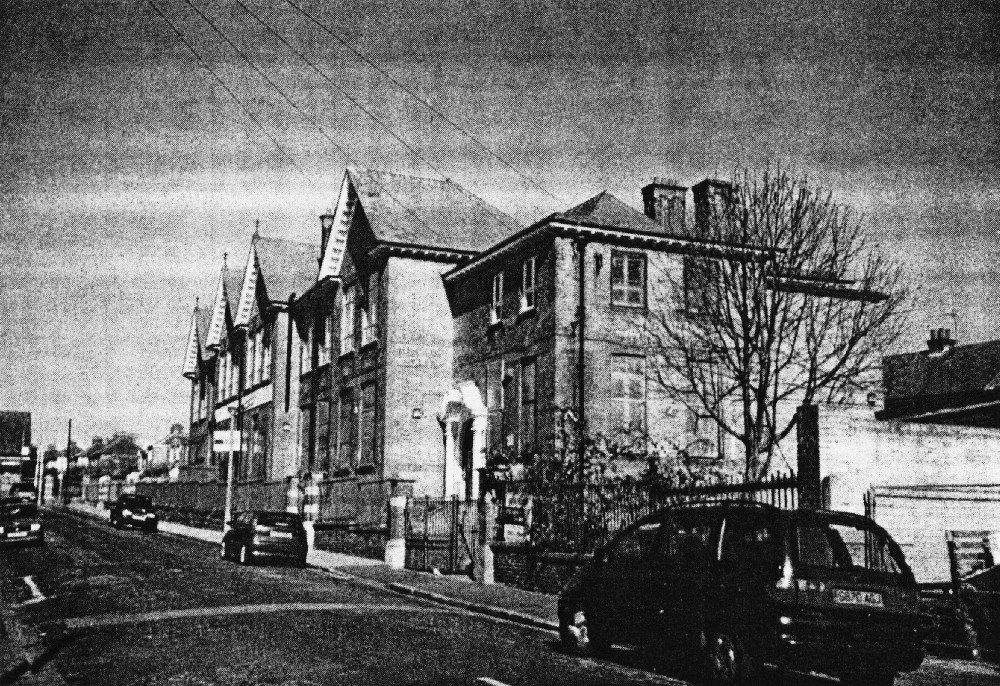
The school, 2003.
But Hereson was far from being only a sports club - free place scholarships were regularly won in spite of overcrowded classes with between fifty and sixty pupils on the roll.
The Second World War
The Second World War affected the school far more than the first one. In common with thousands of others in Britain, Hereson was evacuated, in its case to Staffordshire on 1st June 1940. Before this, in October 1939, Air Raid Precaution Tunnels were built in the school yard.
On that never-to-be-forgotten June morning over 3,000 Ramsgate children were transported by rail to Staffordshire, and for the teachers who accompanied them there was the added responsibility of their full-time care. Mr Davies, the Hereson Headmaster, acted as Liaison Officer between Ramsgate and the Reception Authority in Staffordshire. He must have felt like the Pied Piper at the head of this motley crowd of children.
Hereson was distributed over a total of twelve villages around Stafford, each batch of evacuees having a Hereson teacher or teachers with them, with the result that there were Hereson boys, girls, infants and staff in each of the village schools.
Not all the Ramsgate children were evacuated, however, and some returned from evacuation, sufficient to open part of the school in January 1942 as a Mixed and Infants' School. MrJ. Hartley and five teachers were in charge of 290 children. They were soon repeating the experiences of the First World War, for there were alerts announced this time by the horrible wailing siren, and once again they had to take shelter.
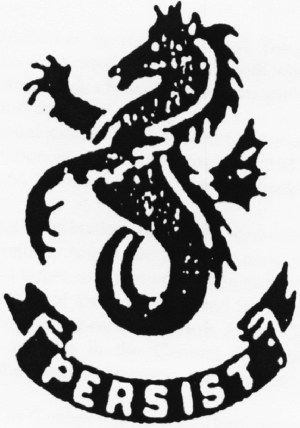
The Seahorse
In April 1942 part of the school became a Senior School with ninety-three boys and girls aged 11-14 years. To the free school first started in October 1934 were' added school dinners, and for the first dinner sixteen children stayed.
On 30th August 1943 the school returned home from Stafford. The evacuation was over. The school was an all-age mixed Junior and Senior School. Though the war was far from over, air raids were less frequent and school life was again more or less normal.
In 1945 the school passed from the authority of the town, which had done so much for it, to the Kent Education Committee, and was formally renamed the Hereson County Modern Secondary School. This was in line with the reorganisation of education under the 1944 Education Act which provided for three types of school: Grammar, Technical and Modern. Three years later, by a transfer of pupils between Ellington and Hereson Schools, and the despatch of the primary schools to Hollicondane, the Hereson County Secondary School for Boys came into being. As a beginning the new school built a woodwork, metalwork and art department in Horsa Huts next to the site of Hollicondane School. With the raising of the school leaving age to fifteen in 1947, and the increase of pupils due to the development of new housing estates at Newington and elsewhere, by 1952 there were 480 boys in fifteen classes, with seventeen members of staff.
Mr Davies retired in 1951 and his place was taken over by Mr E.B. Marsh early in 1952. That same year, after much discussion, the old school colours were changed to maroon and silver, to emphasise the creation of the modern school. The printed school magazine, 'The Hornet', became the duplicated 'Seahorse'. There were new houses with vigorous house competition in boxing, chess, table tennis, gymnastics and swimming, as well as soccer, cricket and athletics.
The Sailing Club, which organised annual cruises to the inland waterways of Holland and Belgium, achieved the distinction of a BBC programme in 1957 after being storm-bound on the Belgian coast, and therefore missing the first week of the Autumn Term.
In 1955 the school set up its own leaving examination, called the Hereson Certificate of Education, requiring passes in English, Arithmetic and one other school subject. This was to provide the boys with a target, and parents and employers with a guide to their proficiency. At this time many of the boys prepared for academic and external examinations as entry to the Forces Apprentice schools. Police Cadets, etc. In 1958 the first two boys sat for subjects in the General Certificate of Education. This means that boys extended their required leaving age to sixteen, thus obtaining qualifications of national value.
The following year the school celebrated its Golden Jubilee - fifty very interesting years. Founded by the Education Act of 1902 and built by the Ramsgate Borough Council, re-ordered by the Hadow Report of 1926 and brought up to date by the 1944 Act. Fifty very full years.
Appendices
1) In the first fifty years the school had three Headmasters:
1909-1930 Mr Percy Solly
1930-1951 Mr W.H. Davies
1952- Mr E.B. Marsh
2) In 1999 the school moved to a new site at the old Holy Cross School in Broadstairs. It kept its name and traditions of the past ninety years. The story from 1959 to date is for another day.
Acknowledgements
Various Old Boys
School Magazines